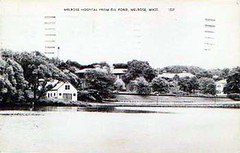Athabasca Oil Sands
History
The Athabasca oil sands are named after the Athabasca River which cuts through the heart of the deposit, and traces of the heavy oil are readily observed on the river banks. Historically, the bitumen was used by the indigenous Cree and Dene Aboriginal peoples to waterproof their canoes. The oil deposits are located within the boundaries of Treaty 8, and several First Nations of the area are involved with the sands.
Athabasca oil sands on the banks of the river, c. 1900
The Athabasca oil sands first came to the attention of European fur traders in 1719 when Wa-pa-su, a Cree trader, brought a sample of bituminous sands to the Hudson’s Bay Company post at York Factory on Hudson Bay where Henry Kelsey was the manager. In 1778, Peter Pond, another fur trader and a founder of the rival North West Company, became the first European to see the Athabasca deposits after discovering the Methye Portage which allowed access to the rich fur resources of the Athabasca River system from the Hudson Bay watershed.
In 1788, fur trader Alexander MacKenzie (who later discovered routes to both the Arctic and Pacific Oceans from this area) wrote: “At about 24 miles (39 km) from the fork (of the Athabasca and Clearwater Rivers) are some bituminous fountains into which a pole of 20 feet (6.1 m) long may be inserted without the least resistance. The bitumen is in a fluid state and when mixed with gum, the resinous substance collected from the spruce fir, it serves to gum the Indians’ canoes.” He was followed in 1799 by map maker David Thompson and in 1819 by British Naval officer Sir John Franklin.
Sir John Richardson did the first geological assessment of the oil sands in 1848 on his way north to search for
Pages: 1 2 3 4 5 6 7 8 9 10 11 12 13 14 15 16 17 18 19 20 21 22 23 24 25 26 27
